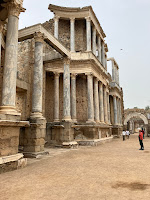It was a glorious day, cool but sunny. Yesterday, I wore my down jacket; today, just a light pullover.
I spent much of the day walking across, or between, fields, some with a wheat crop under way, for I was on la plaine de Caen. I walked through woods as well, along lanes, rural roads, and when I could not find a balise to save my life, I plodded the last five kilometres along the D36 into Harmars. There I waited for Dominique, kind soul, to pick me and take me back to Ouistreham.
Just in case anyone thinks I am not walking a real camino, see the evidence to the left. Perhaps not along this particular path, but pilgrims would walked to le Mont-Saint-Michel, and then continued on to join the Chemin de Tours near Poitier, on to Saint-Jean-Pied-de-Port, and along the Camino Francés to Santiago.
Only one misadventure today, a misadventure with a moral!
I was walking down a country lane when the road turned suddenly to the right. In front of me was a farm gate and on the gatepost was the balise, indicating my path across the field. Or was it? Was I instead to go right, whereupon the balise had been put on the gatepost because there was nowhere else to put it and only a fool would climb over a closed gate to enter a farmer’s field? I turned right and walked a few hundred yards to the end of the lane, hoping to find a path to the left around the field. No luck.I returned to the gate.
It was a large farm gate with three heavy horizontal bars. It was roped closed, but embedded in the ground, so I couldn’t have easily opened it anyway. I mounted the first bar, swung my leg over the top, balanced precariously, and dropped down on the other side.
I crossed the large field, and then another, but could see no way out. And then, far across
to the right, I could see, sitting on the ground, a large sign, what seemed to be a large version of the mont bleu. Escape at last, I thought, and headed across the field. But it was a rather colourful pump.Back across two fields to the rusty old farm gate, another climb and perilous balance, and back to the end of the lane. What had I missed?
There on the other side, in the direction I had not expected to go: a little opening and a balise.
And the moral, the lesson relearned: Never Assume. And perhaps another couple as well: Things are not always what they seem, and, Look carefully!
And as I walked across one of those large fields, alone in a wide open space, I heard the song of the larks.
There are two bird songs that I love beyond measure. One is the Australian magpie. The other is the European lark.
I saw one once, a small unassuming bird that you wouldn’t give a second glance. As I recall the photo I took, I am reminded of a small, unattractive Pekingese kind of dog, the sort that would stand a good chance in an ugly dog contest. (I hope I’m not offending any birders here.) Normally you don’t see the larks, but hear them singing far above you as you cross a field. Some birds glide effortlessly across the sky, but the larks flutter frantically to keep aloft. How can they sing while expending so much energy? To me, their song is not one of beauty like that of the thrush or nightingale, but one of endurance, hope, a struggle to survive, and perhaps faint joy. Birds have become important national symbols. We all know what nations have adopted the eagle as their symbol. I leave you to imagine what countries might be symbolized by the lark. Sorry to wax avian, but I would visit Europe merely to hear the song of the larks.
And speaking of small, nondescript dogs, one managed to get into my photo of the daffodils.
 |
| I wandered lonely as a cloud That floats on high o'er vales and hills, When all at once I saw a crowd, A host, of golden daffodils. (Wordsworth) |
This is the end of my walk for the time being. I hope to continue and walk across the bay to the Mont-Saint-Michel. I shall find a guide. It is one thing to misread a bus or train timetable, but quite another to miscalculate the movement of the tides.
















